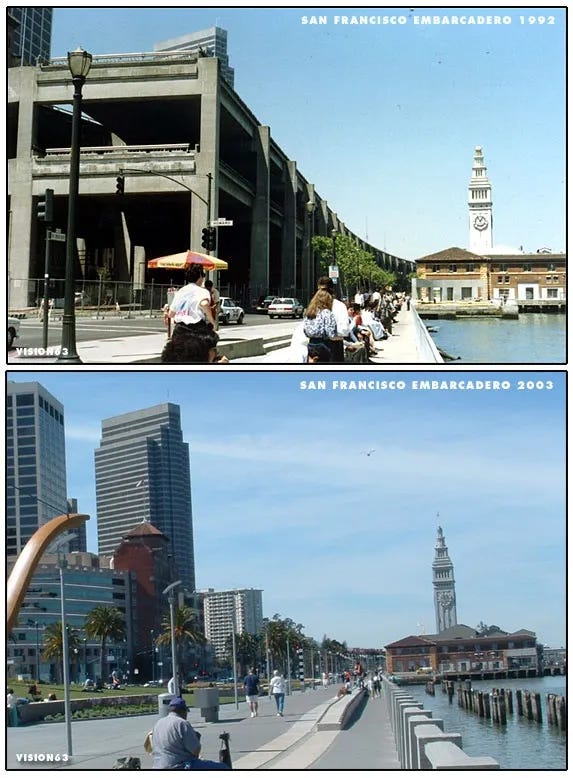🎵 Life is a highway. I want to ride it until we realize we need to change our infrastructure to better meet the needs of society. 🎵 (Song at the end. For real.)
Sometimes, our freeways are wrong.
That’s not a punchy metaphor to explain educational innovation. It’s an historical observation…that is also a punchy metaphor to explain educational innovation.
Pit-Stop History Lesson: In 1955, San Francisco built the Embarcadero Freeway along the city’s north-eastern waterfront. Almost immediately, people saw it as a double-decker concrete mistake. Still, it stood until the 1989 Loma Prieta earthquake created a, ahem, seismic opportunity to remove it (You’re welcome). Within a few years, it was torn down, and now you can walk along the waterfront rather than see the bumper of the person in front of you.
It’s Bay-eutiful (You’re welcome again).
Education is Infrastructure
Schools are the social, emotional, and intellectual highway system of how we operate as a society. They take kids from today to tomorrow, and when those students exit into adulthood, they use the skills they’ve learned along the way to navigate the world (and ideally impact it for the better).
How we design those roads of learning is impactful. It always has been. And for the longest time, those roads have needed redesigning. AI just makes that more visible.
Every time I drive somewhere and see a Your Tax Dollars at Work sign, I’m reminded that we, as a society, can actually find money to fund the things we think need funding; we change things we care about if we really want to. The issue is what we care about.
Sometimes those road signs point to fixed potholes and new onramps, but every once in a while, they point to a holistic reimagining of where a road should and should not be. Only then am I compelled to write about the simultaneously most boring and integral word in English: infrastructure.
Stay awake with me here.
We pretend that education is too enigmatic to change beyond a new tech tool here and a new smart board there. We pretend that infinite discourse outside of school is change itself within schools. We pretend that this is how it’s always been done is a valid excuse to not do the hard work of changing a system that needs changing.
The only people who know different, who don’t pretend but rather work to change that highway of learning are educators.
Education is made out of people, policies, thoughts, and feelings. Everyday, faculty, staff and admin work within rigid systems to help students develop the flexibility needed to navigate a world that looks holistically different than the schools they are growing up in.
The axiom We’re preparing students for jobs that don’t exist yet is more true today than it was yesterday. And it makes less and less sense to keep things the way they are as a result. AI is redefining how the world operates. The discourse around how AI should impact schools will likely continue for a long while, which reflects how complicated schools are.
What is clear, though, is that, regardless of how you feel AI should or should not exist within schools, this is a Richter-scale moment to redesign an education system that better meets students where they are and better allows teachers to do the same.
The Many Moving Parts
Education is process-oriented. Learning doesn’t just happen. It is a years-long layering process for students to build the social, emotional, and personal skills to move from grade to grade and school to school.
Similarly, any small shift within a school takes a lot of time and energy. Cultivating buy-in for new initiatives, no matter how big or small, is challenging, even when people are aligned that it’s the right thing to do. The expectation that AI tools can seamlessly be integrated into the complicated process of teaching reflects a misunderstanding that teaching—and schools, for that matter—are simple. It also reflects a misunderstanding that changes just happen in schools the way they happen in other industries.
In San Francisco, people voiced their displeasure at the Embarcadero Freeway for decades until a narrow vote to demolish rather than fix after the earthquake finally won out.
In education, that voice sounds like burnout. It sounds like the frustration of wanting to teach to your full ability but being given limited resources to do so. It sounds like a sigh in an afternoon faculty meeting.
But it also sounds like optimism. It sounds like an inward smile when an activity clicks for that one student. It sounds like the look in a student’s eye when you ask how the game was this weekend. And it sounds the silent decision in the spring to do it all again for one more school year.

AI is not the paradigm shift tired teachers have been waiting for. It’s not the catalyst of redesigned schools. It’s not the key to unlocking student-centered teaching and learning.
We’ve had that opportunity all along.
We have had an opportunity to rethink education year in and year out, and we have chosen not to year in and year out. Why? Because, well, it’s hard. Ugh, so many moving parts. But that is the surest sign that it’s the thing to do.
The hard work is always worth doing.
Ask a teacher.
AI Bonus Track 🎤
The latest country-rock single “Redesigned Highways” from Mr. Scuderi & The Eclectic Electives, off their sophomore album “Dance Chaperones.”






This line hit me hard: “Education is made out of people, policies, thoughts, and feelings.” That truth so often gets lost in the noise of reform. Your metaphor of infrastructure is powerful, especially the reminder that we’ve always had the opportunity to redesign, but we often choose not to. AI may be a spark, but it’s people, educators, who carry the torch. Thank you for writing with such clarity and care, Danny.